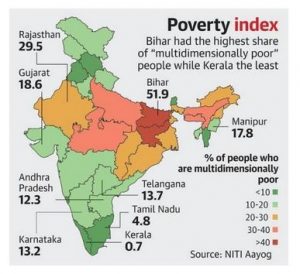THE CONTEXT: Niti Aayog in its report on multi-dimensional poverty in India attempted for the first time to look at the poverty issue through a holistic perspective rather than the sole prism of income. This article lets us understand the state of multi-dimensional poverty in India and how India can overcome it.

METHODOLOGY OF THE REPORT
DIMENSION: Health
WEIGHT: 1/3
INDICATOR (WEIGHT): Nutrition (1/6)
DEPRIVED OF: A household is considered deprived if any child between the ages of 0 to 59 months, or woman between the ages of 15 to 49 years, or man between the ages of 15 to 54 years -for whom nutritional information is available- is found to be undernourished.
INDICATOR (WEIGHT): Child Adolescent Mortality (1/12)
DEPRIVED OF: A household is deprived if any child or adolescent under 18 years of age has died in the household in the five-year period preceding the survey.
INDICATOR (WEIGHT): Maternal Health (1/12)
DEPRIVED OF: A household is deprived if any woman in the household who has given birth in the 5 years preceding the survey has not received at least 4 antenatal care visits for the most recent birth or has not received assistance from trained skilled medical personnel during the most recent childbirth.
DIMENSION: Education
WEIGHT: 1/3
INDICATOR (WEIGHT): Years of Schooling (1/6)
DEPRIVED OF: A household is deprived if not even one member of the household aged 10 years or older has completed six years of schooling.
INDICATOR (WEIGHT): School Attendance (1/6)
DEPRIVED OF: A household is deprived if any school-aged child is not attending school up to the age at which he/she would complete class 8.
INDICATOR (WEIGHT): Cooking Fuel (1/21)
DEPRIVED OF: A household is deprived if the primary source of cooking fuel is dung, agricultural crops, shrubs, wood, charcoal or coal.
INDICATOR (WEIGHT): Sanitation (1/21)
DEPRIVED OF: The household has unimproved or no sanitation facility or it is improved but shared with other households.
INDICATOR (WEIGHT): Drinking-Water (1/21)
DEPRIVED OF: A household is deprived if it does not have access to improved drinking water or safe drinking water is more than a 30-minute walk from home (as a round trip).
DIMENSION: Standard of Living
WEIGHT: 1/3
INDICATOR (WEIGHT): Electricity (1/21)
DEPRIVED OF: A household is deprived if it has no electricity.
INDICATOR (WEIGHT): Housing (1/21)
DEPRIVED OF: A household is deprived if it has inadequate housing: the floor is made of natural materials, or the roof or walls are made of rudimentary materials.
INDICATOR (WEIGHT): Ownership of Assets (1/21)
DEPRIVED OF: The household is deprived if it does not own more than one of these assets: radio, Tv, telephone, computer, animal cart, bicycle, motorbike, or refrigerator; and does not own a car or truck.
INDICATOR (WEIGHT): Bank Account (1/21)
DEPRIVED OF: No household member has a bank account or a post office account.
FINDINGS OF THE REPORT
- Poverty Levels: Bihar has the highest levels of poverty in the country followed by Jharkhand and UP. Kerala has the lowest level of poverty followed by Puducherry, Lakshadweep, Goa, and Sikkim.
- Malnutrition: Bihar has the highest level of malnourished population followed by Jharkhand, Madhya Pradesh, Uttar Pradesh, and Chhattisgarh.
PROBLEMS WITH THE REPORT
- Old Data: The report was created using the data of NFHS-4 which was conducted between 2015 and 2016 and thus doesn’t include the impact of recent government policies on poverty alleviation.
- Focus on Subsistence: The indicators focus on minimum need and not a life that can uphold human dignity. For example, a household is deprived of electricity if it has no electricity. So, if the household gets electricity for just an hour then also it will not be counted as deprived.
USES OF THE REPORT
- Sensitization of Agencies: The report will sensitize government, researchers, civil society, citizens, and other stakeholders on the need for and importance of MPI as a powerful policy instrument.
- Policy Formulation: MPI can be used as a useful input for the design and development of policies schemes, budget allocations, and target setting. This can help India target SDG’s in a better manner.
- District Levels: At the district levels, MPI could help decide the priority of execution and delivery.
THE WAY FORWARD
- Trend Analysis: Conducting NFHS every three years and then subsequent MPI revision will reduce the lag in the reflection of development outcomes and provide the required trend of poverty alleviations.
- Reform Action Plans for the State/UTs: NITI Aayog has prepared a template for the reform action plan through consultations with central ministries, now the states need to modify it taking into account their realities, development challenges, and priorities.
- Sharing of Good Practices: A dashboard needs to be created for sharing best practices between the states for overcoming poverty.
THE CONCLUSION: Poverty alleviation is the biggest goal of Indian governance and the Multi-dimensional Poverty Index by Niti Aayog is a step in the right direction for identifying the magnitude of the problem and for finding the key areas that require attention for poverty alleviation.
Spread the Word

